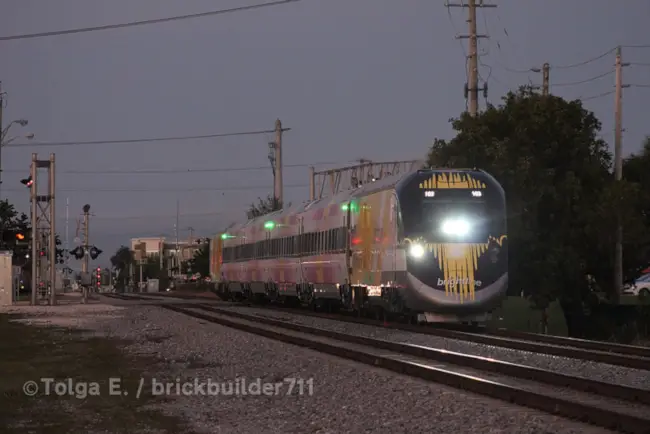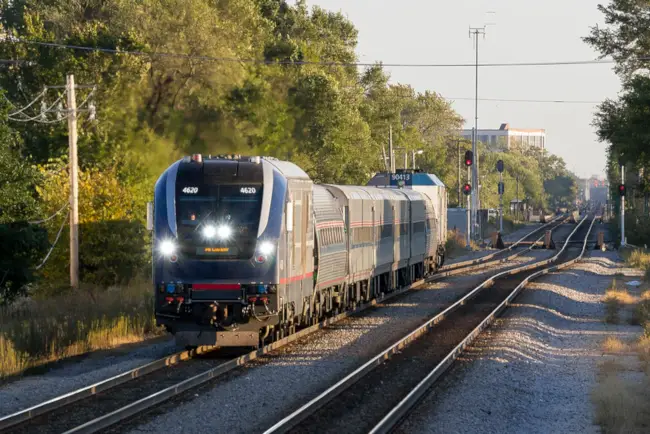With the venerable Genesis units well over twenty years of age, Amtrak began researching a viable replacement for the fleet of two-hundred strong units. With the success and reliability of their ACS-64 electric locomotive which commands the congested Northeast Corridor route after replacing the AEM-7 locomotive, Amtrak looked towards Siemens Mobility for a fleet of low emissions, high performance passenger diesel locomotives.

Introduced in 2017, the Siemens Charger 4,400 hp (SC-44), and Siemens Charger Brightline 4,000 hp (SCB-40) are one of the newest generations of passenger diesels in the North American market. Upon its introduction, the Charger has become the staple for Amtrak routes in California and the Midwest. The type has become popular with various railroads throughout North America, as along with the initial order for western and Midwestern short haul routes, Amtrak has placed an order for long distance versions to supplement and eventually replace the venerable Genesis units. The Chargers are manufactured at Siemens Mobility’s environmentally friendly Sacramento facility, as it is powered by solar.
Operators
Virgin Trains USA (formerly Brightline)
The Siemens Charger Brightline 4,000 hp (SCB-40) ordered by Florida’s Brightline (now Virgin Trains USA), utilizes ten train sets on their Miami-Orlando passenger service. The SCB-40 is differentiated from standard Chargers, as it sports a streamlined front end, with the front coupler hidden behind the pilot. These locomotives and passenger cars were both manufactured by Siemens Mobility, as they are designed to operate as a train set with a locomotive on each end.
The Brightline is the first privately owned rail service in the United States in over 100 years, as the locomotives and rolling stock were privately funded with no public dollars, additionally, it operates on the privately owned Florida East Coast Railway.

Siemens Stainless Steel Railcars
Because the Chargers ordered by Brightline were part of a train set, Siemens constructed sleek stainless steel railcars that set themselves apart from the rest. Typically, because of their inexpensive construction, standard passenger cars are built with corrugated sides, however, Brightline wanted their services to attract passengers and ensure that they provided the best comfort possible. The spacious cars include wide aisles, which encouraged movement throughout the train.
Amtrak
Amtrak currently operates Charger locomotives on their Surfliner, an intercity route connecting San Luis Obispo and San Diego, California. The addition of the Charger locomotives on the route replaced the reliable EMD F59 PHI locomotives that commanded the route for over twenty-five years. Amtrak Midwest in conjunction with the Illinois Department of Transportation operates thirty-two examples of the type on various services throughout the Midwest including the Lincoln Service, Illinois Zephyr/Carl Sandburg, Hiawatha Service, and Wolverine Service/Blue Water/Pere Marquette services.
In addition to these units, two were ordered for northern California services in 2016, in addition to eight units for Amtrak/Washington state’s “Cascades” services,which plans to add two additional services between Portland and Seattle upon their implementation. In 2018, Amtrak ordered seventy-five long distance variants of the Charger for use on their transcontinental routes, therefore, replacing various examples of the Genesis units. Amtrak also has an option for a further one-hundred units to replace the roster of Genesis units.

Maryland Area Regional Commuter (MARC)
MARC purchased eight locomotives for $58 million, aiming to replace its aging AEM-7s on various commuter services in the Baltimore area, as the agency eventually plans to switch to an entirely diesel powered fleet.
Altamont Corridor Express (ACE) and Coaster
ACE ordered four SC-44 locomotives for their peak hour services between Stockton-Jose, California in the heart of Silicon Valley. Coaster ordered five SC-44 locomotives for its San Diego-Oceanside route, mainly operating during peak hours.
VIA Rail Canada
Looking to increase speeds and service on the Quebec City-Windsor Corridor with 32 SCB-40 train sets similar to the Brightline versions,Via Rail placed an order for 32 SCB-40 train sets. According to Siemens, the vast increase of patronage of 30%, yielding 4.5 million passengers annually, constituted the fleet improvement. According to Siemens Canada, due to the low emission prime mover and exhaust treatment of the Charger locomotives, Via Rail expects an 80% reduction in carbon emissions compared to the current equipment. Canada is no stranger to Siemens, as they are the first North American country to employ Siemens light rail systems in the 1970s in Edmonton and Calgary. The implementation of these light rail systems led to the widespread success of Siemens in the North American market.

Technical
The SC-44 Charger has a horsepower rating of 4,400, while the streamlined SCB-40 has 4,000 hp. The locomotive is powered by a Cummins 16-Cylinder QSK-95 4 stroke prime mover, supplying power to four Siemens AC traction motors, which deliver 65,000 lbs of tractive effort to the rail. Head End Power (HEP), on the locomotive is supplied from a static inverter, whose power is generated from the prime mover. The locomotives adhere to the U.S. tier IV standards, with their low emission and efficient prime mover, which includes quad turbocharging, the Cummins Modular Common Rail Fuel System, and a Selective Catalyst Reduction (SCR) exhaust treatment. The prime movers are constructed at Cummins’s faciltiy in Seymour, Indiana. (Railway Age) With a top speed of 125 mph, the Charger is capable of hauling any passenger service on any railroad. Interestingly, the Charger is equipped with both dynamic and regenerative braking. The energy utilized by the dynamic brakes are to be stored in resistors, which is utilized to assist with HEP generation when the need arises.

The Charger locomotives include various safety features called the Crash Energy Management System, which includes a reinforced monocoque carbody, full length anti-climbers, and push-back couplers which assist in crew comfort and safety. The locomotive’s operators cab and clean engine room design allows for ease of maintenance and operation, and is based on the proven Vectron locomotive, which is heavily utilized in Europe. Ease of maintenance is prevalent, as the piping and cabling for the locomotive is easily accessible underneath the engine room walkway, therefore, increasing maintenance and turnaround time, while protecting these crucial components from the elements. (Siemens)
The locomotives are equipped with Siemens SF4 integral welded truck frames, truck suspended traction motors and partially suspended gearboxes, which allow for increased ride quality and locomotive stability. According to Amtrak, the addition of the 75 long distance Chargers will reduce Nitrogen Oxide by over 89%, particulate matter by 95 %, and provide diesel fuel savings of 10%.
| Builder | Siemens Mobility |
| Wheel Configuration | B-B |
| Truck/Bogey | Siemens SF4 |
| Wheel Diameter | 44 in |
| Minimum Curve | 250 ft |
| Wheelbase | 32 ft 6 in |
| Length | 71 ft 6 in |
| Width | 10 ft |
| Height | 12 ft 6 in |
| Axle Load | 67, 500 lb |
| Adhesive Weight | 100% |
| Weight | 264,556 lb |
| Fuel Capacity | 1,800 gallons |
| Prime Mover | Cummins QSK 95 |
| RPM Range | 600-1800 |
| Traction Motors | Siemens Alternating Current (AC) |
| Prime Mover Cylinder Size | 5,9375 liters |
| Head End Power (HEP) | 890 hp static inverter attached to prime mover |
| Braking | Electropneumatic/Dynamic/Regenerative |
| Max Speed | 125 mph |
| Horsepower | SC44: 4,400 hp SCB40: 4,000 hp |
| Tractive Effort | 65,000 lbf starting 62,000 lbf continuous |

